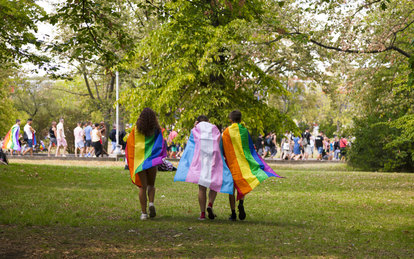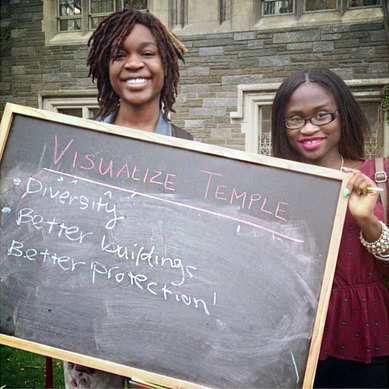Campuses that Embrace and Empower LGBTQ+ Students

The underlying systemic inequities highlighted by the COVID-19 pandemic and concurrent Black Lives Matter protests have underscored the need for traditional institutions like colleges and universities to redouble efforts to break down barriers and ensure students of all races, ethnicities, genders, gender expressions and sexual orientations feel welcome on campus.
One of the most enduring lessons from a student’s on-campus experience has nothing to do with chosen majors or examinations. It is the experience of living, learning and socializing with students from different social, economic and racial backgrounds. Connecting with a wide range of peers helps students succeed within an increasingly diverse society and economy. But this experience requires two components that are acute challenges for colleges and universities in fall 2020—how to safely reopen their physical campuses amid the COVID-19 pandemic and how to make their campuses welcoming and inclusive for all students.
When students arrive on campus, they bring their complete personal identities. The intersectionality of their racial, economic and cultural backgrounds influences the strengths and challenges they bring to the classroom. A range of sexual orientation and gender expression identities are becoming more common on university and college campuses. According to a fall 2019 survey conducted by the American College Health Association that polled 38,000 college students across the country, 18% of learners identified as being other than heterosexual. As society evolves and students feel more comfortable “coming out” about their sexual orientation or gender identity, this historically invisible population will continue to grow in prominence on campus.
For LGBTQ+ and questioning students, the on-campus experience is fundamental for their personal development. The COVID-19 pandemic has required the majority of students to retreat from campus and embrace online learning, leaving many LGBTQ+ students at home with parents who may not support their identity or orientation. This health crisis has highlighted the significance of the campus experience for many LGBTQ+ students who need the autonomy to explore their own identities away from their childhood structure.
Despite the promise of independence, the on-campus experience comes with its own threats. According to Campus Pride, an organization working to create safer college environments for LGBTQ+ students, 70% of first-year LGBTQ+ college students consider leaving school out of fear from being bullied or harassed. LGTBQ+ students of color face increased marginalization as a result of their multiple oppressed identities.
When LGTBQ+ students remain on campus and engaged, they benefit from a higher education. Just as important, when heterosexual and cisgender students collaborate with LGBTQ+ students, they also learn how to succeed within a diverse campus culture.1 Considering both the benefits and threats of the on-campus college experience, colleges and universities must adapt in order to more effectively attract and retain LGBTQ+ students. LGBTQ+-focused polices and programming such as non-discrimination policies, health coverage, hate crime prevention training and convenient gender inclusive/single occupancy restrooms in every building are only the beginning.
Our Campus Planning and Higher Education teams are passionate about designing campuses that are inviting and inclusive for students of all racial, ethnic, gender, gender identity and sexual orientation communities. As campus planners and designers, how can we help ensure LGBTQ+ students feel welcome from the moment they step on campus? Each of our campus projects present us two opportunities to make LGBTQ+ students feel welcome. First, during the planning engagement and secondly within our design.
Listen to Learn
Our philosophy for engagement is grounded in raising awareness and building understanding of the root sources of systemic discrimination that have historically benefited white, straight, cisgender males and marginalized people of color, women and the LGBTQ+ community. Understanding how the physical campus can perpetuate injustice first requires careful listening. We are striving to encourage safe spaces for authentic dialogue for those who feel most at risk, such as students experiencing basic needs insecurity, mental health challenges, or high stress related to first generation/low income cohort experiences.
We seek out and listen to as many different voices from on- and off-campus as we can to inform our master planning and building design projects. Not only should we invite people in, we should go to students in their safe spaces and on their time. During initial focus group interviews, we should specifically seek out the LGTBQ+ student group, LGBTQ+ staff groups, and faculty from LGBTQ+ studies programs. One way to demonstrate empathy and active listening is to use gender-neutral language, share our own preferred pronouns, ask for the preferred pronouns of others and use them consistently.
Design to Empower
When we listen intently, the needs of the LGBTQ+ community can be effectively integrated into the vision and program of the campus plan or a new building. It is our role to guide project stakeholders to consider the varied needs of intersectional students using tools such as our “Day in the Life” persona workshop. During programming for the Student Success Center at City College of San Francisco, the project stakeholders considered the needs and expectations of a wide variety of potential user types. We used hypothetical "personas," including an 18-year-old Black genderqueer person and a 33-year-old white cisgender gay male, to spur discussions about equitable resources for assisting at-risk identity groups. Our team stressed the concept of intersectionality to better understand how multiple factors compound the risks and barriers to success for students coming from multiple identities. Though this project is still in design, this deep engagement is shaping the building programming and space planning.
During the preparation of the campus master plan for the University of Illinois at Urbana-Champaign, our team completed an in-depth analysis of student life facilities. This included numerous stakeholder engagement interviews to better understand both the quality and quantity of space. In one meeting with the Department of Inclusion & Intercultural Relations, they noted that the existing LGBT Resource Center was in a great location—the Illini Union—but was in tight quarters. In our conversations with the resource center staff and students, we learned that the Illini Union’s central location and welcoming feel outweighed any concerns about space constraints. Based on this insight, we recommended removing all non-student-facing offices from the building and consolidating previously scattered student organizations into the Illini Union to join the LGBT Resource Center. This relocation at the heart of campus elevates the visibility of these student organizations, helping students with diverse identities feel embraced by the campus community.
These are just two examples of our team’s experience looking at projects through the lens of equity and inclusion for the LGBTQ+ community. As a campus planner, I am focused on broadening our user engagement process to create inclusive campuses for all students. I am confident our team will continue to learn and modify our actions to reflect new knowledge and insights. I am excited to see what we uncover as we continue to discover and share lessons from our work at the nation’s future-focused higher education institutions who are also embarking on integrating just, equitable, diverse and inclusive principles into the campus planning and built environment.
1 For clarity of terms, LGBTQ+ includes lesbian, gay, bisexual, transgender, and questioning or queer. The plus denotes many other identities on the sexual orientation and gender identity spectrum. A cisgender person is someone whose gender identity corresponds with the sex the person had or was identified as having at birth. Many resources define the terms used in this spectrum, including this guide from NIRSA.
